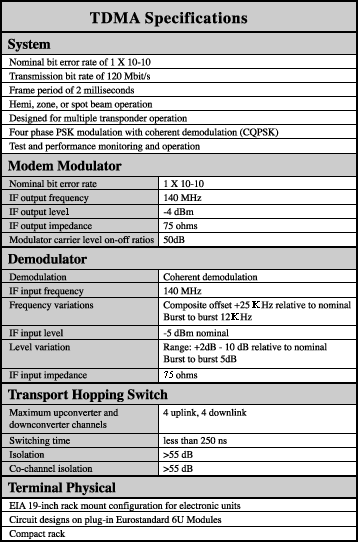|
We have extensive satellite experience in
the United States, Latin America, Europe, the Middle East, and the
Far East. We provide advanced earth station equipment or complete
satellite turnkey solutions for private networks. In addition, many
of the largest commercial networks, such as AT&T, Sprint, MCI
WorldCom; national telecom operations in the UK, France, Germany,
Canada, Singapore and Brazil; and many government owned networks (PTTs) use our satellite solutions.
Our satellite earth
station products, which include both primary and back-up links,
provide high capacity backbone circuits to remote parts of the
globe. For example, both commercial and government networks use our
state-of-the-art satellite TDMA terminals. We have all the
engineering and technical support resources to design, install,
test, and manage satellite systems and train your personnel in their
use and maintenance.
Using our second generation, compact
satellite TDMA terminals, installed in over 34 countries around the
world, customers can realize a 3:1 cost savings over earlier
versions of this technology. Our turnkey satellite systems include
system engineering, installation, testing, training, program
management, and superior products and subsystems. The TDMA terminal
is also available as a standalone product.
|
TDMA
Technology
With time division multiple access (TDMA)
technology, you get higher satellite resource use than you can with
frequency division multiple access technology, such as INTELSAT IDR.
The result? Lower bandwidth cost. For more than a decade, the
INTELSAT TDMA system has delivered virtually error free service and
outperformed all other INTELSAT transmission and access methods. The
incremental growth opportunity of the INTELSAT TDMA system and its
flexibility in rerouting traffic translates to lower system
operating costs.
|
 |
|
TDMA GNS and COMSAT Laboratories
jointly developed the model 2760 TDMA terminal. This product
delivers efficient and cost effective access to INTELSAT's satellite
capacity. INTELSAT markets TDMA satellite service to its signatories
operating in the Atlantic, Pacific, and Indian Ocean regions. This
product currently serves customers in Europe, Latin America, the
Middle East, the Far East, and Africa. This solution, which provides
up to 120 Mbps of digital bandwidth, is cost effective for users
with traffic requirements for 100 to 200 voice circuits and 10 or
more destinations. Customers use this product to interconnect
various public switched networks throughout the world and to enhance
intersatellite Internet connectivity.
Features
- INTELSAT second generation TDMA terminal
- Significantly reduced cost and size
- Cost savings relative to IDR even for modest size traffic
streams
- Enhanced traffic monitoring and diagnostic features that
surpass the INTELSAT requirements of IESS-307
- Soft decision forward error correction for unsurpassed BER
performance with standard A or B earth stations
- As many as 24 (48 E1 Interfaces) direct digital interfaces
(DDIs) with redundancy
- Flexible DDI channel routing capability - standalone channel
grooming equipment is not necessary
- Low maintenance, digitally implemented modem
- Hemi, zone or spot beam operation
Advantages
- Relatively low initial terminal investment
- Low cost expansion of traffic with flexibility to meet
changing traffic requirements
- Increased reliability and ease of operation and
maintainability
- Backward compatible with older satellite TDMA systems
- Exceeds INTELSAT's IESS-317
- Dynamic response to daily busy hour requirements
- Test and performance monitoring and operation
- Superior service availability and stability
- Service availability of better than 99.99 percent with
continuous operation for more than 15 years.
- Simple operations and maintenance; reduced service outages
because of operator error
- Available as a turnkey solution integrating the Model 2760
Terminal with existing or new IF and RF equipment and integration
- Desktop computer system control with user-friendly graphical
menus
- traffic quality and equipment status monitoring and traffic
rearrangement that are not possible with the first generation TDMA
terminals
- Training courses for operators
Description
The Model 2760
second generation INTELSAT TDMA complies with the original INTELSAT
low cost TDMA traffic terminal system specifications. The terminal
is also backward compatible with existing systems. The
second-generation terminal uses the most modern state-of-the art
digital technology and has a color graphics user interface and
compact equipment rack. Expansion space within the compact equipment
bay accommodates as many as 24 (48 E1 interfaces) DDIs with
redundancy. The TDMA terminal is partitioned into the operator
console, IF subsystem, the common TDMA terminal equipment, digital
orderwires, DDIs, and the digital redundancy switch.
The
operator console provides a modern X-Windows color graphics user
interface for all operator display and control. The operator console
interfaces to the other subsystems through a highly reliable local
area network. The operator console software supports remote
operations and provides an upgrade path for emerging network
management protocols, such as the Telecommunications Management
Network (TMN).
The common TDMA terminal equipment has
enhanced features that surpass the basic INTELSAT requirements of
IESS-317. These features include burst time plans to respond to
daily busy hour requirements automatically. Built-in test
capabilities and performance monitoring ensure high reliability of
better than 99.99 percent.
|
Very Small
Aperture Terminals (VSAT)
To meet the growing demand of private
network owners and cost effectively reach remote parts of the globe,
VSATs have become essential in many applications. These products are
selected from several suppliers to meet the specific network
requirements of our customers. Large commercial users, such as
retail outlets, that have many geographically dispersed field
locations and need to transmit data frequently, reliably, and cost
effectively are one application for this product. New members of the
public telecommunications service industry, such as competitive
access providers (CAPs), that do not have sufficient traffic at
their remote locations to justify a large earth station are another
application.
GNS also provides complex communications
equipment used in satellite earth stations that provide high
capacity backbone circuits to remote parts of the globe. With its
full portfolio of network access and radio equipment, GNS can
provide virtually every element of your network.
|

